
Introduction.
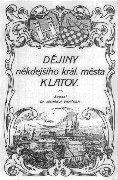 Below is text
from the monograph: Dr.J.Vancura: History
of the former royal town of Klatovy (2693 pp. in 5 volumes,
issued 1927-1936 by O.Cermak's printing house at Klatovy)
that tells of a Vaclav Vyborny and Jiri Vyborny who lived
in the town of Klatovy in southern Bohemia,
relatively distant from Kutna Hora and N.Brod. Since Vaclav
was buying property as a tailorís guildmaster it is likely that
he was born before 1575. Their relationship to any other Vybornys
is unknown. Their use of the Vyborny surname precedes Frydrich
Vyborny which could raise doubts about the Vyborny/Cernik legend.
Below is text
from the monograph: Dr.J.Vancura: History
of the former royal town of Klatovy (2693 pp. in 5 volumes,
issued 1927-1936 by O.Cermak's printing house at Klatovy)
that tells of a Vaclav Vyborny and Jiri Vyborny who lived
in the town of Klatovy in southern Bohemia,
relatively distant from Kutna Hora and N.Brod. Since Vaclav
was buying property as a tailorís guildmaster it is likely that
he was born before 1575. Their relationship to any other Vybornys
is unknown. Their use of the Vyborny surname precedes Frydrich
Vyborny which could raise doubts about the Vyborny/Cernik legend.
At least three possible explanations could be considered:
1. They were members of a separate Vyborny family (families)
who did not leave any descendents or his descendents are unknown to
this site.
2. They were members of the same Vyborny family (families)
that current Vybornys are descended from but for some reason moved
to the town of Klatovy.
3. The Vyborny family may have originated in Klatovy,
Southern Bohemia. Vaclavís and/or Jiri's descendants or relatives
may have moved eastward into central and eastern Bohemia
(Tabor,
N.Brod,
V.Podol,
Caslav and Kutna Hora)
from where most of the Vybornys are descended.
Since Klatovy was forced to become catholic after
the introduction of the Jesuits in 1636, it might have given
the Vybornys reason to leave Klatovy.
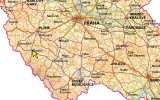 The recent discovery of the records of
Berni rula archive (1654)
could be supposed as some support of the migration hypothesis.
The recent discovery of the records of
Berni rula archive (1654)
could be supposed as some support of the migration hypothesis.
The last hypothesis might explain the tendency of many of the early
family members to have darker features than most Czechs ("The Vyborny
Book" of MUDr. Josef *1864). The royal town of Klatovy was located
on the merchant's road that connected the Bohemian kingdom to
southern Europe. The people of Klatovy would have had more contact
with people from southern Europe than most Czechs. It is possible
that some people from southern Europe settled in Klatovy and
intermingled with the Czech people there.
This material was originally obtained by Dr. Gene Wyborney from a source which has been unknown to the site. It was provided to the site by Leigh Wyborny. Karel Kysilka a Czech genealogist and historian succeeded to indentify this book recently.
Text:
Pages: #I/554, #630, #669, #1244, #1245/46, #II/55
Pag.#I/554:
This page presents a description of individual houses owned by various tailors of Klatovy town. The 5th paragraph is the only one related to Vaclav Vyborny:
" Next to the previous house[No136]there was the house No137. The previous owners are unknown. In 1585 "little Honz" or "Jan Honz the tailor" owned this house. The citizen Vaclav Vyborny bought the house from him [Jan Honz] for 100 kops [kopa = 60 pcs - of some coins - "of Meissen's"] in 1597. The latter still owned this house even in 1619, when a tax of 46 kops and 30 gr [gr = "gros", a smaller coin] for the benefit of the high-born Divis Koc of Dobrs and of Bystrice and of Obytce was charged against this house..."
Pag.#630:
A note regarding Jirik Vyborny who bought the house #63 at Loubsky suburb (southern from the city of Klatovy) in 1600.
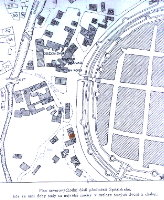
|
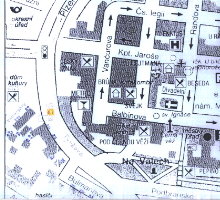
|
Pag.#669:
Jirik Vyborny was murdered in a street conflict in 1613. He left his widow Zuzana [Susan] and little children Jan, Anna and Katerina. The conflict and the subsequent trial briefly described.
Pag.#1244:
A complete text of this page has not been available from Dr.E. Wyborney's archive. The excerpt is:
(First part about Mr. Stephan Stangar being able to join
the tailor's union and how much he paid for his house, etc.)
Mr. Stangar's neighbor was also a tailor, little Hons of
German heritage.
In 1577 he [Jan Honz], Mr. Jan Spulsky, and Tomas
Svoboda, were witnesses to the marriage of Havel Cervenka of
Susice and Anna the daughter of Tomas Kveton of Susice.
Due to incompleteness of the sales record, we do not know from whom
and when Jan Honz the tailor alias little Honz bought house #137 on
Krameriova Street. In 1597 Vaclav Vyborny bought this house
from him [Jan Honz] for 103 kops. The sale was witnessed by Jan Kavin
and Jirik Vrba in the hospital where Mr. Jan Honz lay.
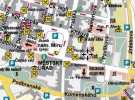
|
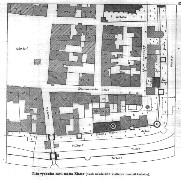
|
Pag.#1245:
The 5th paragraph concerns Vaclav Vyborny:
Vit Jedlicka the tailor bought from Dorota of Kladruby the house "of Vackar's" (No105) on Basta street for 320 kops by the year 1601. The same Vit Jedlicka bought from Jan Pucalka the son of Matej Pucalka half of the hopgarten "Leferovska" under the gallows for 62 kops in 1603. The second half of the same hopgarten he bought from the same Jan [Jan Pucalka] for 73 kops in 1604. In 1609 Vit Jedlicka bought a land (of No105) adjacent to his house from the guardians of Vackar's orphans Katerina and Dorota for 90 kops. In 1607 two tailor's guildmasters Vaclav Vyborny and Jakub Tichy were sent to Prague by an order of the tailor's union of Klatovy to bring complaints on behalf of themselves and all the other young tailors concerning damage of the seal of their guild. This damage to the seal was caused by inadequate care by Vit Jedlicka, their head master, ...
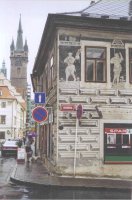
|
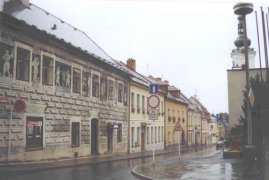
|
Pag.#1246:
...which had been broken and repaired without an approval of the Emperor. Following this complaint on August 21, 1607 the Emperor ordered Vit Jedlicka to bring the seal of the union of Klatovy to the Emperor's Office. He [Vit Jedlicka] had to wait for the Emperor's decree. No information about this outcome was preserved.
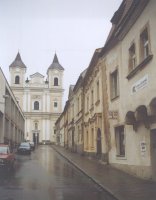
|
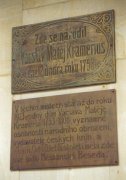
|
From the tailor's guildmasters this year, Vaclav Vyborny was owner of the house No.137 on Kramerius's street [translator's note: names of streets are those used after 1918] which he bought in 1597 for 100 kops from Jan Honz the tailor. His widow Katerina Vyborny owned the house util 1640. He [Vaclav Vyborny] also owned a little house [a cottage] on Chuchle [a locality which still exists in Klatovy town] which he bought from Vaclav Temle in 1615. Jakub Tichy also known as the tailor from Sobeslav town owned the hopgarten named "behind the latch" which he sold in 1611 for 88 kops.
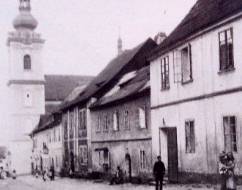 Old photo of Krameriova Street
Old photo of Krameriova StreetPage II/#55:
Contrary to all previous pages this one is of another style - it describes troubles of the citizens of Klatovy town caused by military troops occupying the town. There is an overview given on this page of rates and contributions which different towns and villages of this region was forced to pay to the occupying military forces.
The text of pag.#II/55 is as follows:
"...From Klatovy town there was sent there: 25v [old czech unit of volume] of beer, 200 gb [another unit] of rye, 6 gb of oat, 70 calves, 20 sheep, 60 hens 1).
-------
Note 1)
Beer was sent even from Bezdekov (60?), from Janovice
together with Vesely, Tesetice[?] and Klenovy (6), from
Tejnec (4), from Folyne (8?), from Chudenice[?] (8?), from
Desenice (12), from Besiny (12), from Obytce[?] (1?), from
Male Petrovice (6), from Velke Petrovice (8?), from Nemcice (10),
from Svihov together with Unovice (10) and from Porici (15).
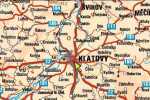 Most of the grain was sent by Porici (100 gb both of rye and of
oats), by Svihov and Unovice (70 gb of rye and 36 gb of oats), by
Desenice and Besiny (60 gb of both commodities), by Hostice[?]
(60 gb of rye and 6 gb of oats), by Nemcice (40 gb of both),
by Bezdekov, Janovice together with Vesely, Tesetice with Klenovy
and by Folyne (40 gb of rye, 25 gb of oats), by Chudenice (
20 gb of both), by Velke Petrovice (20 gb of rye, 20 gb of oats),
by Tejnec and Lhota (a&135; 25 gb of both), by Male Petrovice (25
gb of rye, 20 gb of oats), by Obytce (20? gb of both), by
Cihan[?] (22? gb of both), by Kydliny (10? gb of
rye, 12 gb of oats), by Dolany[?] with Malkovy and by Vrhavec[?]
(10? gb of both). Animals were sent from Poric (4 calves,
8 sheep), from Chodenice (4 sheep only),
from Svihov with Unovice (calves 3, sheep 6), from Besiny
and Dusenice (calves 3 and sheep 6), from Nemcice (calves 2,
sheep 4), from Bezdekov, Janovice with Vesely, Tesetice with
Klenovy (2 calves and sheep), from Male and Velke Petrovice (
calf 1 and sheep 3). A dozen hens were sent by Desenice, by Besiny, by
Male Petrovice, by Cihan, by Nemcice, by Svihov with Unovice and
by Porici. Ten hens were sent by Tynec, by Folyne, by
Chudenice and by Lhotka. Six hens were sent by Bezdekov,
by Janovice with Vesely, by Tesetice with Klenovy, by Vrhavec, by
Kydliny and by Velke Petrovice; by 5 hens were sent by
Dolany with Malkovy and by Mostice. Only Obytce did not send hens.
(ibidem p.55).
Most of the grain was sent by Porici (100 gb both of rye and of
oats), by Svihov and Unovice (70 gb of rye and 36 gb of oats), by
Desenice and Besiny (60 gb of both commodities), by Hostice[?]
(60 gb of rye and 6 gb of oats), by Nemcice (40 gb of both),
by Bezdekov, Janovice together with Vesely, Tesetice with Klenovy
and by Folyne (40 gb of rye, 25 gb of oats), by Chudenice (
20 gb of both), by Velke Petrovice (20 gb of rye, 20 gb of oats),
by Tejnec and Lhota (a&135; 25 gb of both), by Male Petrovice (25
gb of rye, 20 gb of oats), by Obytce (20? gb of both), by
Cihan[?] (22? gb of both), by Kydliny (10? gb of
rye, 12 gb of oats), by Dolany[?] with Malkovy and by Vrhavec[?]
(10? gb of both). Animals were sent from Poric (4 calves,
8 sheep), from Chodenice (4 sheep only),
from Svihov with Unovice (calves 3, sheep 6), from Besiny
and Dusenice (calves 3 and sheep 6), from Nemcice (calves 2,
sheep 4), from Bezdekov, Janovice with Vesely, Tesetice with
Klenovy (2 calves and sheep), from Male and Velke Petrovice (
calf 1 and sheep 3). A dozen hens were sent by Desenice, by Besiny, by
Male Petrovice, by Cihan, by Nemcice, by Svihov with Unovice and
by Porici. Ten hens were sent by Tynec, by Folyne, by
Chudenice and by Lhotka. Six hens were sent by Bezdekov,
by Janovice with Vesely, by Tesetice with Klenovy, by Vrhavec, by
Kydliny and by Velke Petrovice; by 5 hens were sent by
Dolany with Malkovy and by Mostice. Only Obytce did not send hens.
(ibidem p.55).
--------------
The citizens of Klatovy town complained once more of the
great and unbearable troubles caused on their town by Lafuos's
soldiers by sending a letter to the military representatives of
the County at Plzen [Pilsen] town on May 14, 1633. After
they [citizens of Klatovy] could not collect 1000 zl
[zlaty (golden coins)] and 200 Imperial Tolars required
by the captain, he [= the captain] had their councilors
imprisoned.
By Jun 6, 1633 they had collected only 154 Imperial
Tolars. Jiri [George] of Kralevice and Jan Adam Roth
were sent to the military representatives at Plzen to ask for
relief.
To the highest
representative at Ronsperk there were sent for help Jan Mirovsky
and Albrecht Viskovsky. No wonder that many of the neighbors
started to escape from their houses again. The highest
representative had threatened citizens of Klatovy, however, with
severe persecution of those who would not participate in military
contributions. Those persons who had escaped from their houses
were called up to the Council and were ordered to return home.
Especially those were ordered to pay all delayed rates and to be
liable to accomodate soldiers if they would be asked to do so.
They were punished as well by penalty or by an other way. Those
persons who had escaped from their houses have declared [by
the Council] as follows: Slavik - as the house is not of his
possession and as everything had been gathered yet, Vaclav
Vyborny - "as he had to leave the house not
because of pride but because of hardships and as he could not
bear it he had gone", neverthless he would want to
participate to contributions as far as possible; Jan Ryba - as he
had spent more than 200 zl and having debt he had to escape,
neverthless he would want to participate to contributions slowly;
Vaclav Lehomsky - declared let them put forward a bill; Mates
Kynzl - declared he would return to the house and would pay the
contribution; Vaclav Leska - as he is accomodating soldiers;
Dekankova - as she would repair something and then she would
return to the house; another one - she had to escape because she
was thrashened; Samuel Caslava - as the contribution was too high
for him; Vaclav Strasky - that he is at his house again and is
preparing contribution currently; Matous the tanner - as he is
accomodating soldiers and as he had been living at other neighbor
Hostomicky to protect him; Samuel Cestinsky - "as he has to
do with officers and as he does not want to contribute for them
he would prefer a distrainment therefore"; Jan Nedopil - as
he had escaped because it was unbearable for him; Matej of
Netolice and Jan Zachystal had undertaken to pay as far as
possible, Jan Kolinecky as he was raising S[?] and
therefore could not ....
---------------------------------------------------------
Translator's note:
From "The brief history of Klatovy town" (ISBN80-85499-59-2, KCT
1995):
Klatovy founded in 1260-63 as a royal town to protect the
merchant's road from Bohemia to South. During "Hussite" time the
town was one of bastions of "The Tabor's Union of Towns"...
Klatovy town had supported the King Jiri [George] of Podebrady...
Because Klatovy supported the protestant "Czech Noblemen" during
the Battle on the White Mountain the town was occupied by the
Emperor's army commanded by Marradas. Klatovy was forced to
become catholic after the introduction of the Jesuits
in 1636. The town has recovered slowly after military
contributions of that time...
Obviously the Emperor's (= catholic) army had no reasons to be considerate to the citizens. Moreover the soldiers, their local commandant ["the captain"], the higher commandants at Pilsen town and the highest representative were using any occassion to press on Klatovy citizens and to punish them. Apparently some of the citizen had tried to escape from their homes...
Contact:
cv@vyborny.com
Last updated: Sep 23, 2002